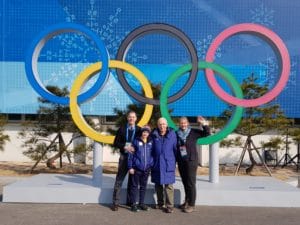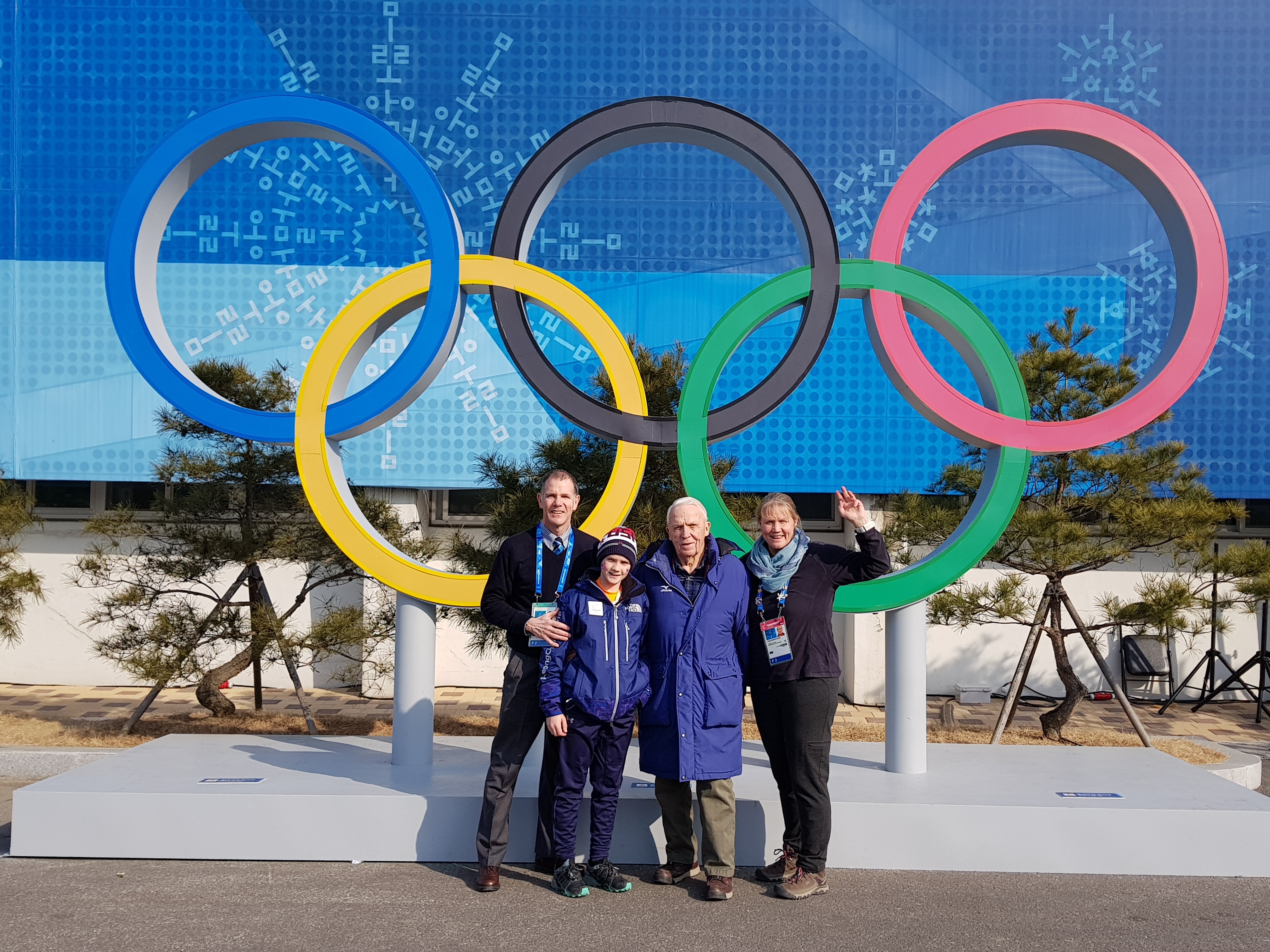by Dennis Dalman
news@thenewsleaders.com
It was a proud family moment when Carl Shobe and his grandfather showed up together at the Winter Olympics in Pyeongchang, South Korea.
Carl, 12, is a student at Kennedy Community School in St. Joseph. His grandfather on his mother’s side is Gene Sandvig, 87, of Minneapolis, who was a competitor as a speed skater for the United States three times in the worldwide Winter Olympics – in 1952, 1956 and 1960.
Carl and his grandfather flew to South Korea in February to see some of the competitions and to be with Carl’s parents, Dr. Joel and Susan Shobe, and also because Sandvig was invited to attend by the Korean Olympics Committee.
Dr. Shobe is an orthopedic surgeon (spine specialist) for St. Cloud Orthopedics in Sartell’s Medical Campus. It was a very happy family time, marred a bit by the fact Shobes’ daughter, Ilsa, could not be with them. She was too busy with her engineering and pre-med studies at the University of Minnesota. Mother Susan also studied engineering.
What brought the Shobes to the Olympics? It was two forms of expertise that dovetailed together. Joel is a medical expert, and Susan is a speed-skating referee. Both were chosen by the International Skating Union, of which both are members, to serve at the 2018 Winter Olympics.
Joel worked at the short-track speed-skating competitions; Susan worked as a championship referee for the long-track speed-skating events.
Joel had served before, at the Vancouver Winter Olympics in 2010. He is one of eight doctors in the world who works, through the ISU, at world-class competitions. Each of the doctors takes turns and serves when the union chooses them. Joel’s duty is to supervise and care for the short-track athletes and to coordinate testing to assure all participants are free of doping drugs.
The Shobes were happy to be chosen to serve this year at the same Olympics event. Susan, who has been a member of the ISU for more than 20 years, is one of the ISU’s 25 championship refugees worldwide. This was the first year the ISU had chosen her to referee at an Olympic event.
Speed-skating and skiing are practically a genetic legacy for the Minnesota-born Sandvig family. Father Gene has been to every Winter Olympics since 1952, the first of the three in which he competed. When Susan was a girl she would accompany her father to many of the games, where he served as a coach or referee. Gene’s wife, Carolyn, 81, has had a lifelong love of downhill skiing. Ilsa is also a speed skater and will soon compete in the World University Games.
Susan’s cousin, Amy Peterson, who was also coached in speed skating by Sandvig, was one of the flag bearers in the Winter Olympics in Sochi, Russia, during its opening ceremony four years ago.
And what about Dr. Joel? Does he skate?
“Well, he’s learning,” said his wife. “He will try just about anything.”
“Mom couldn’t go to the Olympics last month,” Susan said. “She had to stay home, but she will go to the Figure-Skating Championships in Milan, Italy, at the end of March.”
Skating has become such a big part of the Shobes’ lives it’s a wonder how they find the time.
Shortly after their return from South Korea, Susan flew to Salt Lake City, Utah, to referee a Junior Speed-Skating World Championship. Last week, Joel flew to Montreal, Canada, to assist at a short-track speed-skating event. After that it’s off to Milan for the figure-skating competition, the one Susan’s mother will attend.
“The Olympics in South Korea was a great experience,” Susan said. “It was very exciting, and I was so happy to be chosen by the ISU to help out.”
Joel agreed.
“It was a great experience,” he said. “It was such a big event with all the people, all the security, and it was sometimes difficult logistically to get from one place to another. The competitions were fabulous, very exciting. And it was great to be part of it and to help the athletes.”
Fortunately, no catastrophic injuries resulted. In one incident, a man was cut by a skate during training. In another, a woman fell and sprained her ankle badly. As far as incidents of doping, there were none discovered among the skaters, Shobe noted.
The sport
There are two categories of speed skating in the Olympics – short-track skating and long-track skating.
The long-track competition involves two skaters racing in laps against one another in a timed event on a 400-meter-long oval track.
Short-racing involves four to six skaters doing laps around a shorter oval about the size of a hockey rink. Whoever crosses the finish line first wins.
The distances vary by category from 500 meters up to 5,000-meter relays for men and 3,000-meter relays for women.
One of the speed-skating medalists in South Korea was an American – Pennsylvania born-and-raised John-Henry Krueger, 22, who earned silver in the 1,000-meter men’s short-track race.
An American team (Heather Bergsma, Brittany Bowe, Mia Manganello and Carlijn Schoutens) won a bronze medal for the Team Pursuit category.

Dr. Joel and Susan Shobe of rural St. Joseph, who worked at the Winter Olympics in South Korea, stand before the iconic interconnected rings that symbolize the Olympics. Also in the photo is the Shobes’ son, Carl and his grandfather Gene Sandvig of Minneapolis. Sandvig, the father of Nancy Shobe, competed as a speed skater in three Winter Olympics games (1952, 1956, 1960). He was invited to South Korea by special invitation from the Olympics Committee.

Multiple Winter Olympics speed-skating competitor and Olympics coach Gene Sandvig of Minneapolis stands with his grandson, Carl Shobe, next to a speed-skating rink at the Winter Olympics in South Korea. Carl is a student at Kennedy Community School in St. Joseph. His parents, Dr. Joel and Susan Shobe, worked at the Olympics – he as a medical advisor, she as a referee.




